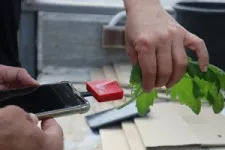(Press-News.org) CHAMPAIGN, Ill. — For the first time, researchers have observed the process of nanoparticles self-assembling and crystalizing into solid materials. In new videos produced by the team, particles can be seen raining down, tumbling along stairsteps and sliding around before finally snapping into place to form a crystal’s signature stacked layers.
Led by Qian Chen at the University of Illinois Urbana-Champaign and Erik Lutijen at Northwestern University, the study used liquid-phase transmission electron microscopy and computational modeling to gain an unprecedented view of the self-assembly process at nanometer resolution. The team said these new insights could be used to design new materials, including thin films for electronic applications.
The findings are published in the journal Nature Nanotechnology.
Before this work, researchers used microscopy to watch micron-sized colloidal particles – 10 to 100 times larger than nanoparticles – self-assemble into crystals. There are also extensive theories on atomic, molecular or ionic building blocks, which are 10 to 100 times smaller than nanoparticles. However, the researchers said a knowledge gap existed at the intermediate nanoscale.
Recent advances to improve liquid-phase TEM have made it possible to view nanoparticles in real time as they form solid materials. Chen’s team spent years optimizing the process to ensure the electron beam could view the particles without damaging them.
“Previously, our team resolved the mystery of nucleation, namely how the embryos of crystals composed of tens of nanoparticles are formed,” said Chen, a materials science and engineering professor at the University of Illinois Urbana-Champaign, who led the experimental work. “With advances in liquid-phase TEM and data science, in this work, we can now capture and track motions of thousands of nanoparticles over time.”
In the new study, researchers used differently shaped nanoparticles – cubes, spheres and indented cubes – to explore how shape affects behavior.
“We know that atoms use a similar scheme to assemble into crystals, but we have never seen the actual growth process,” said Luijten, a materials science and engineering professor at Northwestern who led the theoretical and computational portion of the study. “Now we see it coming together, right in front of our eyes. By viewing nanoparticles, we watch particles larger than atoms but smaller than colloids. So, we have completed the whole spectrum of length scales. We are filling in the missing length.”
In experiments by Illinois graduate students Binbin Luo, Chang Liu, Ahyoung Kim and Zihao Ou, the particles collided, sticking together to form layers. The particles formed a horizontal layer and then stacked vertically to form the layer-by-layer crystalline structure. Sometimes, after sticking to each other, the particles briefly detached to fall onto a layer below. They further visualized crystal formation with advanced computer simulations, verifying the universal trend of distinctive assembly structures from different-sized particles.
“The differently shaped nanoparticles we used wiggle around and communicate differently with each other while in fluids. We sampled their growth behaviors from hundreds of liquid-phase TEM movies to glean a unified understanding for the first time,” said Luo, a former Illinois graduate student, first author of the study and currently with Dow Chemical Company.
Click here to see an advanced computer simulation of how cube-shaped nanoparticles interact to form solid materials
“The movies have a huge amount of information embedded,” said Ou, a former Illinois graduate student who is currently at Stanford University. “We taught our computers to extract the position, shape and the networks they assemble into over time automatically, allowing us to translate the movies to quantifiable physical parameters.”
Kim, a former Illinois graduate student and currently at the University of California, Berkeley, said one unique advantage of nanoparticles is that their shapes and surface chemistry can be facilely changed by synthesis. Liu, a graduate student in the Chen group added, “We studied cubes, spheres and indented cubes; they diffuse differently as they chase after each other, leading to different final shapes of the crystals.”
Luijten said this information will help engineers design new materials. The insight could help design thin-film materials often used to build flexible electronics, light-emitting diodes, transistors and solar cells.
“Knowing how particles come together will enable us to control the shape of a surface,” Luijten said. “Do you want a flat or rough surface? Changing particle shape or how fast the particles fall can affect the surface.”
The U.S. Department of Energy and the National Science Foundation supported the research.
Chen also is affiliated with the Materials Research Laboratory, chemistry, chemical and biomolecular engineering, the Carl R. Woese Institute for Genomic Biology and the Beckman Institute for Advanced Science and Technology at the U. of I.
Editor’s notes:
This is a modified version of a news release distributed by Northwestern University.
To reach Qian Chen, call 217-300-1137; email qchen20@illinois.edu.
The paper “Unravelling crystal growth of nanoparticles” is available online. DOI: 10.1038/s41565-023-01355-w
END
Researchers reveal real-time glimpse into growth habits of nanoparticles
2023-03-30
ELSE PRESS RELEASES FROM THIS DATE:
How plants cope with the cold light of day - and why it matters for future crops
2023-03-30
On bright chilly mornings you can either snuggle down under the duvet or leap up and seize the day.
However, for photosynthesising plants, this kind of dawn spells danger, so they have evolved their own way of making cold mornings tolerable.
Research led by the John Innes Centre has discovered a cold “coping” mechanism that is under the control of the plant biological clock and could offer solutions to breeding more resilience into crops less suited to cold climates.
“We’ve identified a new process that helps plants ...
WPI-led team uncovers new details of SARS-COV-2 structure
2023-03-30
Worcester, Mass. – March 30, 2023 – A new study led by Worcester Polytechnic Institute (WPI) brings into sharper focus the structural details of the COVID-19 virus, revealing an elliptical shape that “breathes,” or changes shape, as it moves in the body. The discovery, which could lead to new antiviral therapies for the disease and quicker development of vaccines, is featured in the April edition of the peer-reviewed Cell Press structural biology journal Structure.
“This is critical knowledge we need to fight future pandemics,” said Dmitry Korkin, Harold L. Jurist ’61 and Heather E. Jurist Dean’s ...
University Hospitals research published in New England Journal of Medicine shows minimally invasive procedure saves most patients with severe vascular disease from amputation
2023-03-30
CLEVELAND – A study published in the March 30 issue of the New England Journal of Medicine has shown that there may finally be an alternative to amputation for patients suffering from chronic limb-threatening ischemia (CLTI), the most severe form of peripheral artery disease. This study, co-led by University Hospitals (UH) Harrington Heart & Vascular Institute, could lead to the first FDA approval of a therapy giving thousands of patients hope for an alternative to limb loss.
THERAPY SAVES MOST PATIENTS FROM AMPUTATION
The PROMISE II U.S. pivotal clinical trial found that minimally ...
Columbia establishes the Center for the Transition to Parenthood with funding from the Bezos Family Foundation
2023-03-30
NEW YORK, NY (March 30, 2023)--With a transformational gift from the Bezos Family Foundation, Columbia will launch the Center for the Transition to Parenthood (TtP) in the Department of Obstetrics and Gynecology (Ob/Gyn). Supported by the most advanced scientific knowledge in the field, the TtP Center seeks to reinvent prenatal care, address the mental health of parents, improve the overall health of their infants, and promote family well-being.
The Center, established with a gift of $21 million from the Bezos Family Foundation, will develop, test, and put into practice a range ...
Form is (mal)function: Protein’s shape lets bacteria disarm it
2023-03-30
Shigella bacteria can infect humans but not mice. In the March 29 issue of Nature, a team from UConn Health explains why. Their findings may explain the multifariousness of a key weapon of our immune system.
Shigella infections cause fever, stomach pain, and prolonged, sometimes bloody diarrhea for as long as a week. The bacteria sicken 450,000 people each year in the US alone. Although most people recover on their own, children and those with weakened immune systems are at risk of Shigella ...
Thermal paint — MXene spray coating can harness infrared radiation for heating or cooling
2023-03-30
An international team of researchers, led by Drexel University, has found that a thin coating of MXene — a type of two-dimensional nanomaterial discovered and studied at Drexel for more than a decade — could enhance a material’s ability to trap or shed heat. The discovery, which is tied to MXene’s ability to regulate the passage of ambient infrared radiation, could lead to advances in thermal clothing, heating elements and new materials for radiative heating and cooling.
The group, including materials science ...
An improved, visible light-harvesting catalyst to speed up reactions
2023-03-30
Photocatalysis is the use of light to accelerate the rate of a reaction in the presence of a photocatalyst. The catalyst plays a crucial role in this process—it absorbs the light being shined onto it and makes it available in way that can help accelerate the chemical reaction and also enhance it. These catalysts are used for a variety of light-dependent reactions ranging from the production of paper to the conversion of carbon dioxide to fuel. Given these applications, the development of ideal photocatalysts is important. An ideal ...
Structure of 'oil-eating' enzyme opens door to bioengineered catalysts
2023-03-30
UPTON, NY—Scientists at the U.S. Department of Energy’s Brookhaven National Laboratory have produced the first atomic-level structure of an enzyme that selectively cuts carbon-hydrogen bonds—the first and most challenging step in turning simple hydrocarbons into more useful chemicals. As described in a paper just published in Nature Structural & Molecular Biology, the detailed atomic level “blueprint” suggests ways to engineer the enzyme to produce desired products.
“We want to create a ...
Allies or enemies of cancer: the dual fate of neutrophils
2023-03-30
Why do cancer immunotherapies work so extraordinarily well in a minority of patients, but fail in so many others? By analysing the role of neutrophils, immune cells whose presence usually signals treatment failure, scientists from the University of Geneva (UNIGE), from Harvard Medical School, and from Ludwig Cancer Center have discovered that there is not just one type of neutrophils, but several. Depending on certain markers on their surface, these cells can either promote the growth of tumours, or fight them and ensure the success of a treatment. By boosting the appropriate factors, neutrophils could become great agents of anti-tumour ...
Shining light on the mechanics of embryo development
2023-03-30
Summary
Scientists have come up with a new method to study the mechanical properties of developing embryos with unprecedented speed
The new method – line-scanning Brillouin microscopy (LSBM) – relies on a microscopy technique based on Brillouin scattering – a phenomenon where light interacts with naturally occurring thermal vibrations within materials.
The method, which can be used to non-invasively study developing embryos in three dimensions and across time, was selected as one of The Guardian's ...









